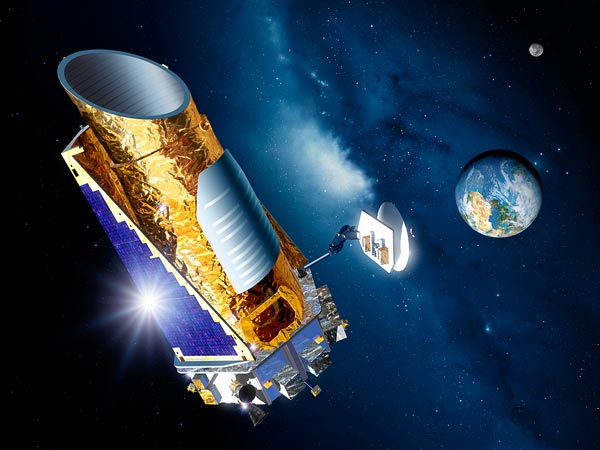Kepler Spacecraft Disabled; "Exciting Discoveries" Still to Come
An artist's conception of the Kepler spacecraft.
The Kepler spacecraft, which has revolutionized our understanding of the vast number of exoplanets beyond our solar system, has been damaged beyond repair, NASA officials said today.
The space agency reported the end of the observing phase of the Kepler mission today, saying that one of three working rotating wheels that helped keep the spacecraft steady as it collected images cannot be repaired.
Kepler stopped working properly in May, and NASA engineers have tried without success to fix the problem since then. "The engineering tests have been completed, and we do not believe we can recover" the third wheel, said Paul Hertz, NASA's astrophysics director.
He said the Kepler team will now determine whether the spacecraft and its telescope can be used for other space research that has been proposed since the problem was first reported. That includes studying asteroids, comets, supernovae, and some large planets in our galaxy.
While the mission to collected information about planets that orbit a small slice of the Milky Way will now end, analysis of the data collected so far will go on for three or four years, and great results are anticipated, said Kepler's science principal investigator William Borucki.
"The Kepler mission is by no means over," he said. "We expect the most exciting discoveries will come in the next years."
Exoplanet Hunter
The Kepler mission, which launched in 2009, has transformed astronomy's understanding of planets beyond our solar system and has proven that they are very common. For instance, there are some 300 billion stars in the Milky Way, and astronomers now believe there are more planets orbiting around them.
The primary goal of Kepler is to determine the frequency of Earth-like planets that orbit stars similar to our sun in one selected area of the Milky Way, and by extension throughout the universe.
Kepler has already detected 135 planets and has identified more than 3,500 candidate planets. It works on the understanding that if an exoplanet crosses in front of its sun, the light from the star will slightly dim; this shows researchers there's a planet in orbit around that star.
So far, Borucki said, Kepler scientists have not found an entirely Earth-like planet in what's called the "habitable zone" around a sun-like star. That zone is the region around the star where temperatures allow for water to be at least sometimes liquid—not perpetually frozen or boiling.
However, because of the way Kepler operates, the data needed to find such an Earth-like planet requires three to four years of watching each of the potential stars with orbiting planets.
The mission did go beyond the four-year mark, and Borucki said he is confident the team has the data necessary to identify such a planet if it is there to be found.
A follow-up mission to Kepler, called the Transiting Exoplanet Survey Satellite (TESS), is scheduled to launch in 2017 and will look for larger and brighter planets closer to our solar system. The area observed by Kepler was 3,000 light-years away.
Oceanful of Data
Kepler has been hardly alone in terms of uncovering the hidden world of exoplanets, with many teams at work using Earth-based telescopes as well.
Kepler was launched with four metal reaction wheels—motors that, when spun up in one direction, cause the spacecraft to move in the other. At least three wheels are needed for the craft to remain stable, and one had already failed in 2012.
So when a second went into "safe mode" in May, Kepler engineers were not optimistic about returning to the needed three-wheel configuration. A decision about whether a two-wheeled Kepler should keep operating will be made by NASA official sin the fall, after the various potential new uses are analyzed and their costs determined.
During a teleconference Thursday, Borucki was asked if he was disappointed at the end of this phase of the Kepler mission. He replied that while he felt "a little regret," but felt far more "satisfaction with what the mission has accomplished" in terms of greatly increasing our understanding of exoplanets.
Before Kepler, he said, it was as if we were at the bottom of an ocean and had virtually no understanding of what was above us. "Now," he said, "we have an oceanful of data to study."
Marc Kaufman
National Geographic
Published August 15, 2013












